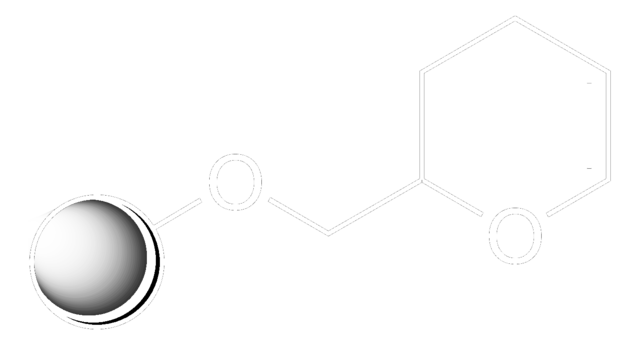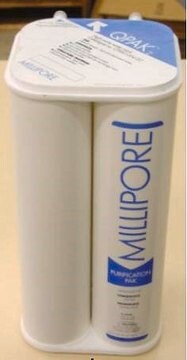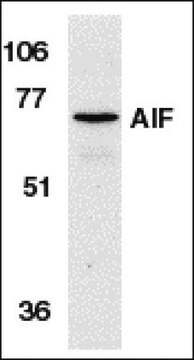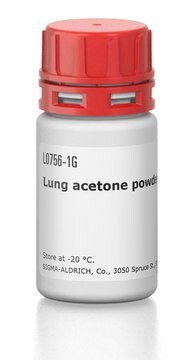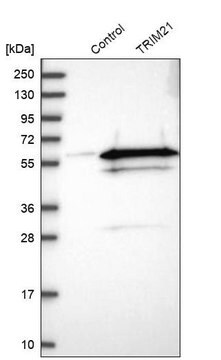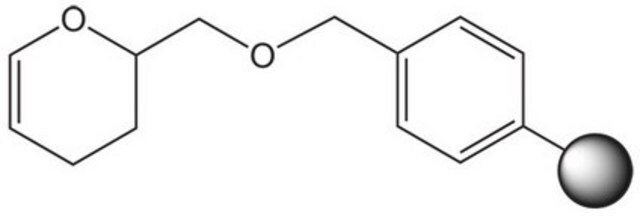推荐产品
生物源
rabbit
品質等級
抗體表格
purified immunoglobulin
抗體產品種類
primary antibodies
無性繁殖
polyclonal
物種活性
human, mouse, rat
製造商/商標名
Chemicon®
技術
immunohistochemistry: suitable (paraffin)
western blot: suitable
UniProt登錄號
運輸包裝
wet ice
目標翻譯後修改
unmodified
基因資訊
human ... AIFM1(9131)
一般說明
Apoptosis is characterized by several morphological nuclear changes including chromatin condensation and nuclear fragmentation. These changes are triggered by the activation of members of the caspase family, caspase activated DNase, and several novel proteins (Zamzami et al., 1999). A novel gene, the product of which causes chromatin condensation and DNA fragmentation, was recently identified, cloned, and designated apoptosis inducing factor (AIF) (Susin et al., 1999). Like the critical molecules, cytochrome c and caspase 9, in apoptosis, AIF localizes in mitochondria. AIF translocates to the nucleus when apoptosis is induced and induces mitochondria to release the apoptogenic proteins, cytochrome c and caspase-9. AIF induces chromatin condensation and DNA fragmentation, which are the hallmarks of apoptosis, of the isolated nucleus and the nucleus in live cells by microinjection. AIF is highly conserved between human and mouse and widely expressed (Susin et al., 1999).
特異性
Apoptosis is characterized by several morphological nuclear changes including chromatin condensation and nuclear fragmentation. These changes are triggered by the activation of members of the caspase family, caspase activated DNase, and several novel proteins (Zamzami & Kroemer 1999). A novel gene, the product of which causes chromatin condensation and DNA fragmentation, was recently identified, cloned, and designated apoptosis inducing factor (AIF) (Susin et al. 1999). Like the critical molecules, cytochrome c and caspase 9, in apoptosis, AIF localizes in mitochondria. AIF translocates to the nucleus when apoptosis is induced and induces mitochondria to release the apoptogenic proteins, cytochrome c and caspase-9. AIF induces chromatin condensation and DNA fragmentation, which are the hallmarks of apoptosis, of the isolated nucleus and the nucleus in live cells by microinjection. AIF is highly conserved between human and mouse and widely expressed (Susin et al. 1999).
免疫原
Epitope: internal domain
Rabbit anti-AIF (Internal region) polyclonal antibody was raised against a peptide corresponding to amino acids 517 to 531 of human AIF (Susin et al. 1999). This sequence is identical to those of mouse and rat AIF (Susin et al. 1999).
應用
Anti-AIF Antibody, internal domain is an antibody against AIF for use in IH(P) & WB.
Research Category
Apoptosis & Cancer
Apoptosis & Cancer
Research Sub Category
Apoptosis - Additional
Apoptosis - Additional
Western blot: 0.25 to 1 μg/mL.
K562 cell lysate can be used as a positive control and a 67 kDa band should be detected.
Immunohistochemistry on formalin fixed, paraffin sections: 5-20 μg/ml, with antigen retrieval; see website protocol for details and photographs.
Optimal working dilutions must be determined by end user.
K562 cell lysate can be used as a positive control and a 67 kDa band should be detected.
Immunohistochemistry on formalin fixed, paraffin sections: 5-20 μg/ml, with antigen retrieval; see website protocol for details and photographs.
Optimal working dilutions must be determined by end user.
標靶描述
67 kDa
聯結
Replaces: 04-430
外觀
Ammonium sulfate precipitation and DEAE-cellulose chromatography
Format: Purified
Purified IgG in PBS containing 0.02% sodium azide.
儲存和穩定性
Maintain for 1 year at 2–8°C from date of shipment. For maximum recovery of product, centrifuge the original vial after thawing and prior to removing the cap.
分析報告
Control
Widely expressed
Widely expressed
其他說明
Concentration: Please refer to the Certificate of Analysis for the lot-specific concentration.
法律資訊
CHEMICON is a registered trademark of Merck KGaA, Darmstadt, Germany
免責聲明
Unless otherwise stated in our catalog or other company documentation accompanying the product(s), our products are intended for research use only and are not to be used for any other purpose, which includes but is not limited to, unauthorized commercial uses, in vitro diagnostic uses, ex vivo or in vivo therapeutic uses or any type of consumption or application to humans or animals.
未找到合适的产品?
试试我们的产品选型工具.
儲存類別代碼
10 - Combustible liquids
水污染物質分類(WGK)
WGK 2
閃點(°F)
Not applicable
閃點(°C)
Not applicable
Carlo Rinaldi et al.
American journal of human genetics, 91(6), 1095-1102 (2012-12-12)
Cowchock syndrome (CMTX4) is a slowly progressive X-linked recessive disorder with axonal neuropathy, deafness, and cognitive impairment. The disease locus was previously mapped to an 11 cM region at chromosome X: q24-q26. Exome sequencing of an affected individual from the
Alfredo Criollo et al.
Apoptosis : an international journal on programmed cell death, 12(1), 3-18 (2006-11-03)
HeLa and HCT116 cells respond differentially to sorbitol, an osmolyte able to induce hypertonic stress. In these models, sorbitol promoted the phenotypic manifestations of early apoptosis followed by complete loss of viability in a time-, dose-, and cell type-specific fashion
Loss of Aif function causes cell death in the mouse embryo, but the temporal progression of patterning is normal.
Brown, D; Yu, BD; Joza, N; Benit, P; Meneses, J; Firpo, M; Rustin, P; Penninger, JM; Martin, GR
Proceedings of the National Academy of Sciences of the USA null
P2X7 receptor differentially modulates astroglial apoptosis and clasmatodendrosis in the rat brain following status epilepticus.
Ji-Eun Kim,Hea Jin Ryu,Seong-Il Yeo,Tae-Cheon Kang
Hippocampus null
Acyl coenzyme A-binding protein augments bid-induced mitochondrial damage and cell death by activating mu-calpain.
Shulga, N; Pastorino, JG
The Journal of Biological Chemistry null
我们的科学家团队拥有各种研究领域经验,包括生命科学、材料科学、化学合成、色谱、分析及许多其他领域.
联系技术服务部门